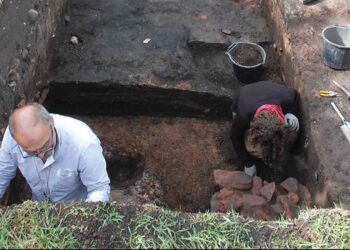
Adding sunlight-reflecting particles into the upper atmosphere could help cool the climate
alexnako/Shutterstock
One of the many dangers of continuing to pump carbon dioxide into the atmosphere is that we could trigger tipping points such as the shutdown of crucial ocean currents. Now, a modelling study suggests that injecting aerosols into the stratosphere to reflect sunlight will reduce this risk – but also that this action will be much less effective if it starts in 2080 rather than very soon.
“My conclusion from this is if you’re serious about preventing tipping [points], you need to take solar radiation management seriously, which means researching its potential benefits and its risks,” says Claudia Wieners at Utrecht University in the Netherlands.
Tipping points refer to changes that couldn’t be reversed for many centuries, if at all. They include the slowdown or halting of ocean currents that play a key role in global climate by transporting immense amounts of heat.
One is the Atlantic meridional overturning circulation (AMOC), which carries heat from the tropics to Europe. If it collapses, there could be rapid sea level rise in North America, a severe drop in temperatures in northern Europe and serious disruption to monsoons across Asia.
Stratospheric aerosol injection is a proposed form of geoengineering that involves adding sunlight-reflecting particles to the upper atmosphere using planes, balloons or rockets.
According to a model used by Wieners’s team, the strength of the AMOC would decline by more than half over the next century in a worst-case emissions scenario. But if stratospheric aerosol injection were used to keep the global temperature rise at around 1.5°C, the current’s weakening would be greatly reduced, Wieners told the Exeter Climate Conference in the UK last week.
In fact, the AMOC declined less in this scenario than in one with rapid reductions of emissions but no geoengineering. “So, actually, at least for the next 80 years or so, [greenhouse gas] mitigation helps less than stratospheric aerosol injection,” says Wieners.
However, if stratospheric aerosol injection is delayed until 2080 and then used to return the global temperature back to 1.5°C above pre-industrial levels after overshooting, there is no recovery in the AMOC, the model suggests.
The team also looked at the North Atlantic subpolar gyre, a circular current linked to AMOC that flows around areas where cold, extra salty water sinks. If this sinking stops because the sea becomes fresher and warmer, it would also have major effects on Europe’s climate.
In a worst-case scenario, the model suggests that the sinking would end and that stratospheric aerosol injection starting in 2080 would be unable to restart it. But if aerosol injection were to begin now, sinking would be preserved in two out of three key regions.
However, the findings need to be confirmed by many more studies looking at more realistic emissions scenarios, says Wieners – and there are several potential dangers. “You could also really badly mess up,” she says.
For starters, successful geoengineering would require close global cooperation for centuries to come. “You might think of it as the greatest governance challenge that humanity has ever faced,” ethicist Stephen Gardiner from the University of Washington in Seattle said in another talk at the conference.
For instance, if stratospheric aerosol injection were done in one hemisphere only – perhaps because of a lack of a global consensus – it would shift the tropical rainfall zone around the world, warns Wieners.
In a third talk, Jim Haywood at the University of Exeter, UK, discussed how model experiments have shown that, if done in certain parts of the world, another form of geoengineering called marine cloud brightening could trigger a “mega-La Niña” so intense that air pressure changes would lead to higher sea level rise in the Pacific over the next century than from warming itself.
Now we know of the risk, it can be avoided, says Haywood. “You just change your strategy.” But many researchers aren’t confident we can manage the risks of geoengineering.
“Solar radiation management makes it sound like a perfectly manageable thing. Shouldn’t we use the term solar radiation interference?” Stefan Rahmstorf from the University of Potsdam in Germany asked Wieners after her talk.
There is also the risk that geoengineering becomes seen as an alternative to cutting emissions. “It does not address the root cause of climate change,” says Wieners. “It is, at best, symptom fighting, but maybe if the symptoms are too bad, it could be a good addition to the true solution.”
Because of these issues, some climate scientists are opposed to even researching the potential risks and benefits of geoengineering. It is so controversial that at least one conference attendee refused to attend a session focused on geoengineering.
Wieners isn’t the first to report that geoengineering might need to start soon to avoid tipping points. Last year, two independent teams concluded that blocking solar radiation might prevent the collapse of the West Antarctic ice sheet – another major tipping point – but only if done soon, and along with big emissions cuts.
“It makes sense that the longer you wait, the higher the risk that something irreversible happens,” Wieners told New Scientist after her talk. “I think that’s pretty obvious.”
Topics:
Source link : https://www.newscientist.com/article/2487346-geoengineering-could-avoid-climate-tipping-points-but-not-if-we-delay/?utm_campaign=RSS%7CNSNS&utm_source=NSNS&utm_medium=RSS&utm_content=home
Author :
Publish date : 2025-07-08 17:00:00
Copyright for syndicated content belongs to the linked Source.







